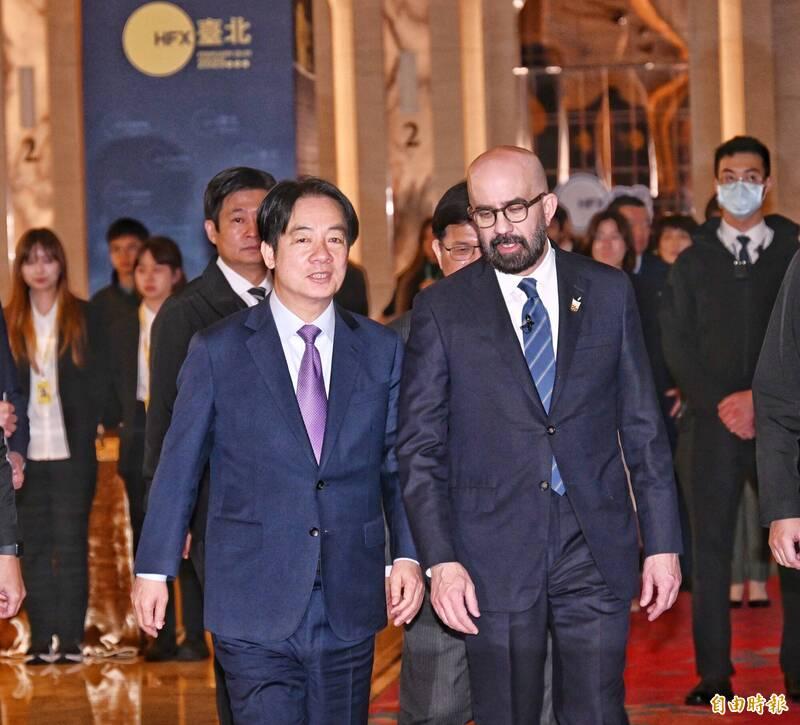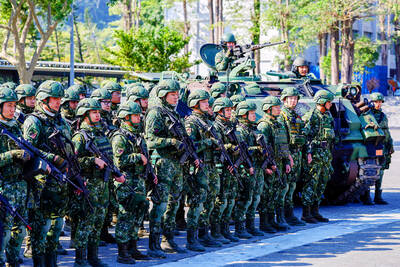President William Lai (賴清德) said the global democratic camp should be more united against authoritarianism, build a global “non-red supply chain” and “bring back the dawn of peace” as he spoke at the Halifax International Security Forum today.
Lai said Taiwan occupies a critical position in the first island chain, safeguarding national sovereignty, maintaining a democratic way of life and defending peace and security in the Taiwan Strait while facing authoritarian threats directly.
Taiwan is to uphold “peace through strength,” he said.

Photo: Fang Pin-chao, Taipei Times
As a responsible member of the international community, Taiwan would not actively provoke conflicts and would maintain the status quo in the Taiwan Strait while being willing to engage in a dialogue with China under the principle of equality and dignity, he said, citing threats to the Indo-Pacific region from China’s large-scale military drills last year.
He said his government had recently proposed a special budget this year to increase defense spending to more than 3 percent of GDP and established a Whole-of-Society Defense Resilience Committee last year, which is to pursue global peace by deepening relations with democratic allies and improving their defense resilience.
Technological strength, being the backbone of national defense, is key to deterring the expansion of authoritarianism, while it is also crucial to improve economic resilience by boosting industrial development, he said.
As a country with a leading position in the semiconductor industry, Taiwan is willing to work with democratic allies to build a “non-red supply chain” to pursue mutual economic benefits and maintain global peace, he said.
Halifax International Security Forum President Peter Van Praagh said the forum being held in Taipei demonstrated the support of the international community for Taiwan.
The two-day forum saw politicians, experts and scholars attend from more than 70 countries, as well as Taiwan’s Minister of Foreign Affairs Lin Chia-lung (林佳龍) and Minister of National Defense Wellington Koo (顧立雄).
It is the first time that the forum is being held outside North America since it was launched in 2009 and it is not a coincidence that it is held in Taiwan which is a vibrant democratic country facing potential aggression from its neighbor using greyzone tactics, Van Praagh told a news conference before the opening ceremony.
The aim of the forum is to explore how the international society should cope with the situation and most importantly what Taiwan can do, he said, adding that Taiwan and the international security forum are a great match.
He thanked United Microelectronics Corp (UMC) founder Robert Tsao (曹興誠), who also gave a speech, for his support.
Asked about how US President Donald Trump’s current stance towards the Ukraine war could affect Taiwan, Tsao said Taiwan can unite and demonstrate its determination to safeguard democracy despite not being able to predict what Trump, whose administration is currently in talks with Russia on ending the war, would do.
The US would not help a country where 60 percent of people support unification, Tsao said, so Taiwan should “help itself before expecting help from others.”
It is more important to get rid of the Chinese Communist Party’s (CCP) “Trojan Horse” in the legislature by the mass recall movement which demonstrates unity and rejects the CCP’s totalitarianism than to guess what the US would do, he said.
The international society views Taiwan as a whole despite its internal differences, elections and recalls, he said, adding that no political struggle should sacrifice Taiwan’s sovereignty and international status.
In his speech, Tsao recognized the forum for excluding China’s participation and not bowing to its pressure by including Taiwan.
Facing challenges brought by the Trump administration, Taiwan’s unanimous goal would be to safeguard national security and stand against Chinese invasion, he said.

UNILATERAL MOVES: Officials have raised concerns that Beijing could try to exert economic control over Kinmen in a key development plan next year The Civil Aviation Administration (CAA) yesterday said that China has so far failed to provide any information about a new airport expected to open next year that is less than 10km from a Taiwanese airport, raising flight safety concerns. Xiamen Xiangan International Airport is only about 3km at its closest point from the islands in Kinmen County — the scene of on-off fighting during the Cold War — and construction work can be seen and heard clearly from the Taiwan side. In a written statement sent to Reuters, the CAA said that airports close to each other need detailed advanced

Tropical Storm Fung-Wong would likely strengthen into a typhoon later today as it continues moving westward across the Pacific before heading in Taiwan’s direction next week, the Central Weather Administration (CWA) said. As of 8am, Fung-Wong was about 2,190km east-southeast of Cape Oluanpi (鵝鑾鼻), Taiwan’s southernmost point, moving westward at 25kph and possibly accelerating to 31kph, CWA data showed. The tropical storm is currently over waters east of the Philippines and still far from Taiwan, CWA forecaster Tseng Chao-cheng (曾昭誠) said, adding that it could likely strengthen into a typhoon later in the day. It is forecast to reach the South China Sea

Almost a quarter of volunteer soldiers who signed up from 2021 to last year have sought early discharge, the Legislative Yuan’s Budget Center said in a report. The report said that 12,884 of 52,674 people who volunteered in the period had sought an early exit from the military, returning NT$895.96 million (US$28.86 million) to the government. In 2021, there was a 105.34 percent rise in the volunteer recruitment rate, but the number has steadily declined since then, missing recruitment targets, the Chinese-language United Daily News said, citing the report. In 2021, only 521 volunteers dropped out of the military, the report said, citing

WEATHER Typhoon forming: CWA A tropical depression is expected to form into a typhoon as early as today, the Central Weather Administration (CWA) said yesterday, adding that the storm’s path remains uncertain. Before the weekend, it would move toward the Philippines, the agency said. Some time around Monday next week, it might reach a turning point, either veering north toward waters east of Taiwan or continuing westward across the Philippines, the CWA said. Meanwhile, the eye of Typhoon Kalmaegi was 1,310km south-southeast of Oluanpi (鵝鑾鼻), Taiwan’s southernmost point, as of 2am yesterday, it said. The storm is forecast to move through central